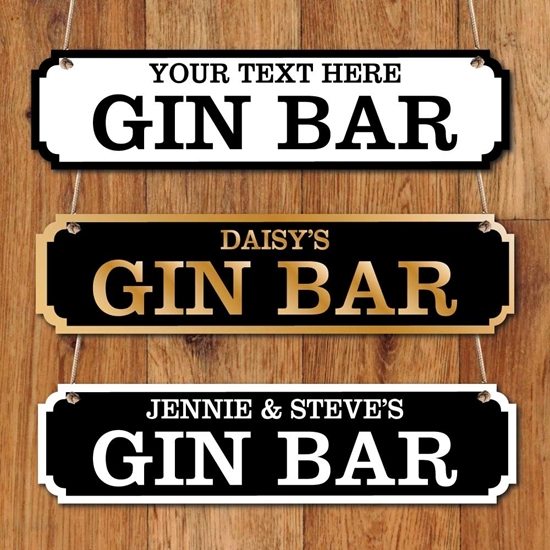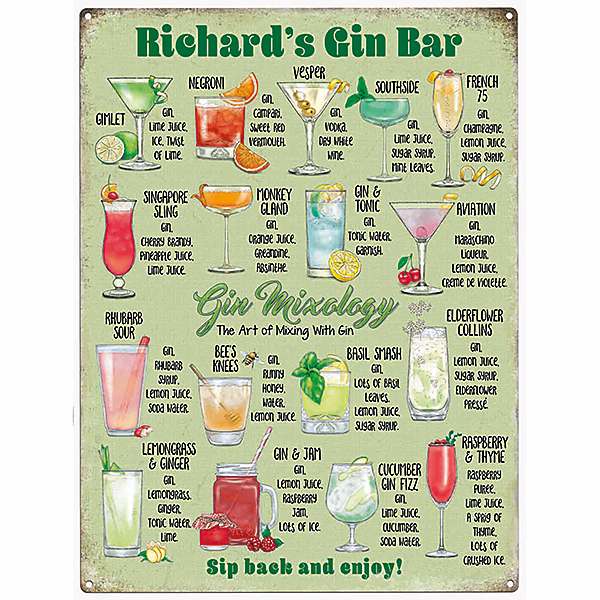Bar signs differ in terms of size based on their intended use, their location and aesthetic. Here's a look at how the differences in size affect the function and aesthetics of bar signs: 1. Large Signs
Attract attention and serve as a focal focus.
Uses : Exterior signage or primary branding signs.
Placement: These are usually installed on walls or larger surfaces outside of the bar to draw customers.
Example: large neon signage, oversized vintage style signs, or huge wall-type signs.
2. Medium Signs
Goal: To give information or enhance decor without dominating the space.
Uses: Signs for direction, menu boards as well as promotional display.
Location: Ideally placed to be easily spotted but not overpowering.
A few examples are signs of medium size for daily specials; metal signs that feature the bar's logo or themed decorative signs.
3. Small Signs
Goal: To provide precise particulars or subtle ornamental elements.
Uses Table signs, small decorative pieces, or labels.
Placement Tables, shelves or displays that permit close-up view.
Examples include table number signs or small frames with quotes.
Size Aspects
Visibility
Large Signs: They are made to be visible from a distance from a distance, which makes ideal for attracting pedestrians and establishing a bar's presence.
Medium Signs: These signs are ideal to balance visibility and effectiveness, and also providing vital information, without imposing decor.
Small signs are ideal for intimate information and close-up details, enhancing the patron's experience at eye level or at the table.
Proportion
Signs should be proportional to the space to avoid overwhelming tiny areas. They are best for open and large spaces.
Medium Signs: These signs can be used in numerous interior spaces. They can be positioned in a variety of ways.
Small signs: Ideal way to add detail, and they fit neatly into small spaces.
Impact
Large Signs: Creates an impact and is a crucial branding tool. They are often employed to set the mood for a bar.
Medium Signs: Strikes the right balance between décor and visibility, adding to the overall mood while conveying important information.
Small Signs: These signs are a great way to add charm and detail that creates a rich and complex visual experience.
Practicality
Large Signs: Requires large mounting solutions and may be more costly due to the size and the materials.
Medium signs offer more flexibility in terms of design and are simpler to set up.
Small Signs: Simple to replace and update They are ideal for environments that are dynamic, like bars where menus or promotions alter frequently.
Functionality
Large Signs: Mainly used to draw attention and increase visibility.
Medium Signs are functional and decorative. They provide you with vital information, while also enhancing your visual.
Small Signs: Mainly used to provide information in a clear manner, they contribute to the overall design and design with a subtle approach.
The ideal size for the bar's sign is determined by its intended purpose, the arrangement of the space and the impact desired on the patrons. Be sure to keep these aspects in mind so that they are contributing to the atmosphere of the bar as well as its needs for operation. Follow the top the original source for bar hanging sign for website advice including design a pub sign, garden pub signs, pub bar signs for sale, personalised sign for bar, the pub sign, bar sign design, the staying inn bar sign, bar sign design, home garden bar signs, pub signs for home bars and more.

What Is The Difference Between Installing And Mounting Bar Signs?
The mounting and installation of bar signs is dependent on the kind of sign, its weight, dimensions, location, and use. This article will offer an in-depth look at the various mounting and placement options for bar signs. Wall-Mounted Bar Signs
Features: Fixes directly onto walls.
Methods:
Screws and Anchors are utilized to anchor heavier signs (metal or wood).
Adhesive Tape: Can be used on lighter signs like foam board or acrylic.
Brackets: They are utilized for signs that must protrude from the wall for better visibility.
Uses: Indoor decor, menu boards, directional signs.
Benefits: Secure, flexible, and allows for prominent display.
Negatives: Walls can be damaged It is also it is difficult to move.
2. Hanging Signs
Specifications They are suspended from overhangs or ceilings.
Methods:
Chains: Ideal for heavy signage, chains are movable and durable.
Cables: Sleeker look, often used for modern designs.
Rods: Provide a rigid support structure.
Uses: Ceiling decor, directional signs, overhead promotional signs.
The vertical space is highly visible and the decorative options are endless.
Negatives
3. Freestanding Signs
Specifications: Not connected to any structure, supported by a base or support.
Methods:
A-Frames are portable and foldable. Often employed for advertising on sidewalks.
Pedestal Stands: Stable base, ideal for indoor use.
Panel and post: Typical for large permanent signs.
Uses: Outdoor advertising, indoor directional signs, promotional displays.
The flexible and portable design makes it easy to alter.
Negatives
4. Window Signs
Specifications Attached directly to windows.
Methods:
Suction cups are easy to set up and take down. They're suitable for signs that weigh less.
Adhesive Glass can be directly applied to the surface of the glass. Perfect for decals, graphics and other designs.
Static Clings are permanent but not permanent. They are reusable and they are easy to put up or take down.
Uses: Marketing and branding, operating hours.
Advantages: Maximizes space in the window and is highly visible outside.
Some disadvantages are: small window sizes, sunlight may affect performance.
5. Signs with Backlit Edge-Lit and LEDs
Specifications: Incorporate lighting into the sign's structure.
Methods:
Wall Mounting With Electrical Connections. It requires an electrical connection and secured connection.
Suspended With Power Cables Hangs with integrated lighting.
Uses menu boards, high-visibility branding, and decorative elements.
Benefits include improved visibility and attractive illumination.
Installation is more complicated and requires electrical work.
6. Temporary & Portable Signs
The design is easy to put up and remove.
Methods:
Pop-Up Stands are lightweight and foldable.
Banner Stands: Roll-up or retractable designs.
Uses: Promotions, events, seasonal decor
Benefits: Easy transport, quick setup.
Negatives Less durable and solid.
7. Magnetic Signs
Attachment using magnetic force.
Methods:
Magnetic Strips: Attached to the back of the signs.
Magnetic Boards. Signs that are attached to metallic surfaces.
Uses: Menu boards with a changeable layout Temporary notices.
Advantages: Easy to change No permanent fixtures are required.
Limitations: Only for magnetic surfaces, they are less secure.
8. Projection Signs
Features Highlights: Project images or words by using light.
Methods:
Mounted Projectors: Securely mounted on ceilings or walls.
Portable Projectors: Placed on stands or other surfaces.
Uses: Events, promotions Displays that are dynamic.
Benefits The sign is not is required, and the content can be easily altered.
Disadvantages
Considerations for Mounting and Installation
Size and Weight
Heavy Signs: You need more robust mounting solutions like anchors and screws.
Light Signs can be made using simpler methods, like adhesive strips or suction cups.
Durability
Permanent Signs: Use more durable and secure mounting techniques.
Temporary signage: Choose methods that allow you to move and relocate the sign.
Location
Indoors: Less concern about weather resistance and more flexibility in materials and techniques.
Outdoor: Must be made of weatherproof materials and a secure mounting system to be able to withstand the elements.
Aesthetics
Concealed mounting: This method gives a more professional appearance by hiding the hardware.
Signs can be enhanced by adding decorative hardware.
Accessibility
Simple Access to Changes: For signs that are updated regularly, such as menu boards.
Security: Ensures the signs aren't easily altered with or snatched.
These factors will help bar owners decide on the appropriate methods of mounting and installation that will work best for their bar. They will be able to ensure that their signage is solid, visible and secure. They are also in accordance with their aesthetics as well as functional requirements. Follow the best learn more here about bar sign hanging for more examples including to the pub sign, outdoor personalised bar sign, pub signs to buy, personalised outdoor pub signs, personalised hanging bar sign, personalised sign for bar, personalised cocktail bar sign, bar signs, personalised outdoor pub signs, personalised signs for bar and more.

What Is The Difference Between Bar Signs In Terms Of Interactivity?
There are a variety of kinds of interactivity that can be applied to bar signs to increase customer engagement and experience. Bar signs can be classified according to their level of interaction. Static Signs
Static signs provide information in a static format.
Common types are: printed posters or painted murals.
2. Digital Displays
Digital signs can be capable of displaying real-time content, including multimedia, animations, and updates.
Interactivity: Touchscreens may provide interactive games menus, interactive games, or other promotional content.
Benefits: Engage patrons, capture attention and deliver relevant information.
3. QR Codes
Interactive Links: QR codes that are printed on signs may link to menus, promotions, or social media profiles.
The benefits of this app are Access to more information and offers.
4. LED Screens
LED screens can display animated text, video and animations.
LCDs with touch capabilities let patrons interact with content like choosing menu items or playing games.
Benefits: Draw attention, communicate information clearly and create an immersive experience.
5. Projection Mapping
Immersive experiences: Projection mapping converts flat surfaces into interactive displays with interactive visuals.
Interactivity - Patrons are able to interact with projected elements such as interactive games or virtual experiences.
Benefits: Improve the ambience and increase social interaction.
6. Augmented Reality (AR).
Enhanced Reality: AR overlays digital content onto the physical world and provides immersive experiences.
AR-enabled sign allows customers to interact with digital elements such as viewing recipes for cocktails or playing virtual games.
Benefits: Differentiate your bar from the competition by offering distinct experiences that are engaging for patrons and creating a buzz.
7. Motion Sensors
Motion sensors detect movement and trigger an interactive response in signs.
Interactivity Signs react to the movements of patrons by showing animations or altering the content. They can also provide specific messages.
Benefits You can create immersive environments that amaze your customers.
8. Social Media Integration
Online Interaction: Signs may feature hashtags or social media handles to encourage patrons to engage online.
Users-generated Content: Encourage patrons to share pictures of the signage on social media platforms, extending the bar's reach and visibility.
Benefits : Increase the involvement of communities, boost the visibility of brands, and generate user-generated material.
9. Interactive Lighting
Dynamic Effects: Interactive LED signs or neon signs can react to touch, sound or movements.
Signs that interact alter their hue, brightness and patterns in response to patron interaction or environmental clues.
Benefits: Improve ambience and create immersive environments.
10. Gamification
Interactive Games: Signs that include interactive games and challenges to entertain customers and encourage participation.
Offer rewards such as discounts or gifts to those who complete challenges or win games.
Benefits: Increase time to stay encourage social interaction and encourage repeat visits.
Bar owners who include interactive elements in their signage will create an engaging experience that catches the attention of patrons, boost brand awareness and distinguish their business from a highly competitive market. Check out the top make a pub sign for site examples including design a pub sign, bar wall signs, the staying inn sign, pub wall sign, the staying inn sign, bar signs, personalised garden bar signs, home bar pub signs, to the bar sign, pub signs to buy and more.
